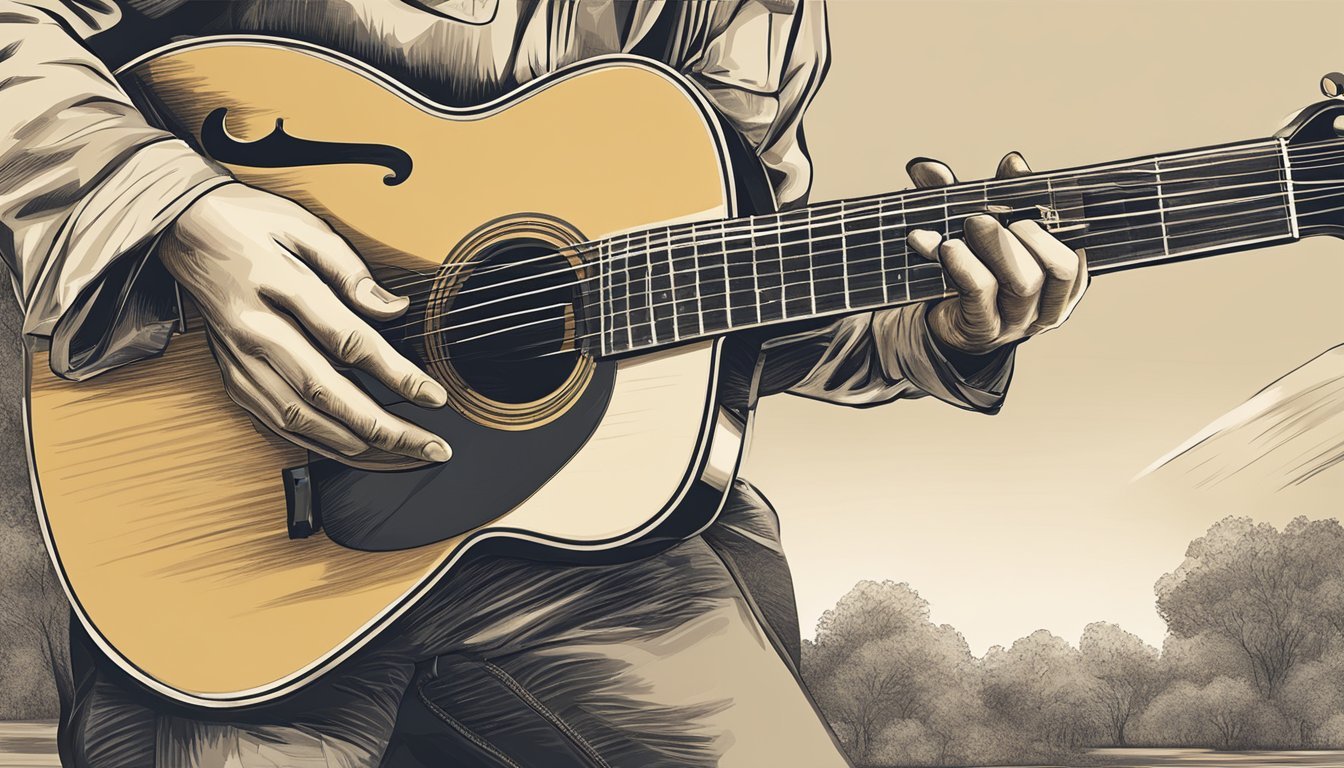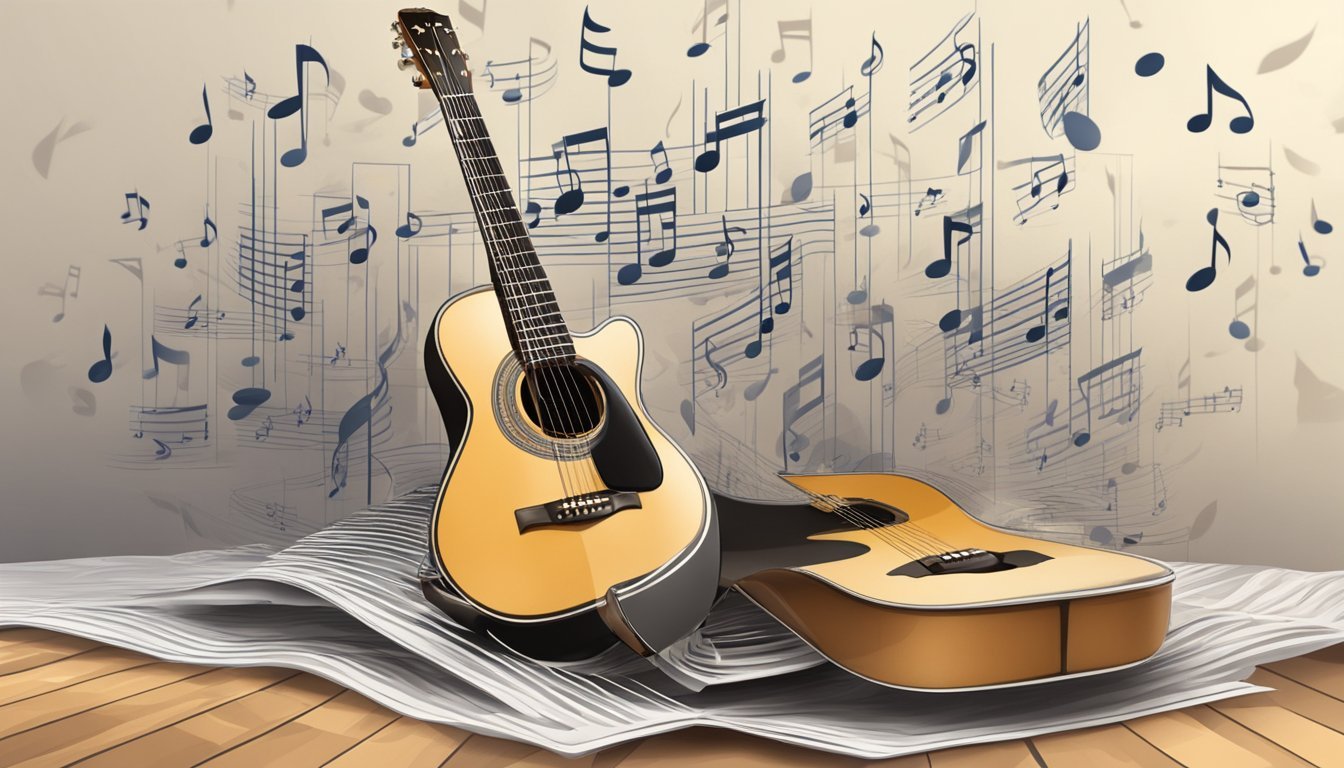An acoustic guitar is a popular musical instrument known for its rich sound and versatility. It produces music through the vibration of its strings, which resonates within its hollow body, creating beautiful harmonics. Whether you are a beginner or an experienced player, this instrument offers a unique way to express yourself through music.

With roots dating back centuries, the acoustic guitar has evolved significantly over time.
Today, you can find various types, including the steel-string guitar, which is favored for its bright sound.
Learning the anatomy of the guitar and mastering different playing techniques can enhance your skills and enjoyment.
Exploring the world of acoustic guitars opens doors to countless styles and genres.
Understanding what to look for when choosing your guitar can make a big difference in your playing experience and sound quality.
Key Takeaways
- Acoustic guitars create sound through string vibration and resonance.
- There are many types of acoustic guitars, each with distinct features.
- Choosing the right guitar enhances your playing experience and sound.
History and Evolution
The acoustic guitar has a rich history that spans many centuries.
From its ancient origins in stringed instruments to the innovations of key figures, the journey of the acoustic guitar is fascinating.
Throughout the years, the acoustic guitar has evolved significantly, incorporating various designs and materials that enhance its sound quality and playability.
Key innovations, such as the development of the modern dreadnought shape and the use of new woods, have contributed to its popularity among musicians.
Today, understanding the acoustic guitar features and benefits can help aspiring players choose the right instrument for their musical journey.
From Oud to Lute
The story begins with the oud, a stringed instrument that emerged in the Middle East around 3500 BC.
This early instrument had a pear-shaped body and no frets, making it unique.
You’ll see its influence in later instruments.
Following the oud, the lute became popular during the Renaissance.
It had a rounded back and frets, which allowed for more complex melodies.
Artists in Europe embraced the lute, leading to its widespread use in music.
Both the oud and lute laid the groundwork for what we now know as the acoustic guitar.
Birth of the Modern Acoustic Guitar
The modern acoustic guitar began taking shape in the 19th century.
Antonio Torres Jurado, a Spanish guitar maker, is often credited with this evolution.
He introduced a larger body and designed the guitar to have more volume and better sound quality.
Torres also refined the bracing structure inside the guitar, which helps support the top while enhancing tone.
His designs are still influential today.
The evolution continued with instrument makers who sought to innovate, paving the way for the acoustic guitars we see in music stores now.
Key Innovators: Torres and Martin
Another key player in the guitar’s evolution was Christian Frederick Martin.
In the 1830s, he brought European crafting techniques to America, improving guitar production.
Martin’s guitars were known for their quality and unique sound.
He popularized the X-bracing method, which provides stability and enhances resonance.
This innovation became a standard in guitar-making.
Together, the contributions of Torres and Martin shaped the acoustic guitar into a beloved instrument for musicians everywhere.
Their innovations made it accessible, allowing you to enjoy its music today.
Anatomy of an Acoustic Guitar
Understanding the different parts of an acoustic guitar helps you appreciate how it produces sound.
Each component plays a vital role in the instrument’s overall function and tone.
Body Styles and Sizes
The body of the guitar is crucial for sound quality and volume.
Acoustic guitars come in various shapes and sizes, like dreadnought, concert, and parlor.
- Dreadnought: This is the most common style. It has a large body, producing deep bass tones.
- Concert: A bit smaller than a dreadnought, it offers brighter sound and easier playability.
- Parlor: With a compact size, it is great for fingerstyle playing.
The body’s shape affects how sound waves resonate, impacting your playing experience.
The Soundboard and Bracing
The soundboard is the top part of the guitar body, and it greatly influences the sound.
It amplifies vibrations from the strings and shape the tone.
Bracing refers to the internal support structure on the soundboard.
You’ll notice different bracing patterns, like X-bracing or fan bracing.
- X-bracing: Provides strength and is commonly used in many guitars.
- Fan bracing: Often seen in classical guitars, this pattern offers a warmer tone.
These elements work together to enhance acoustics, volume, and projection.
Fretboard and Strings
The fretboard, or fingerboard, is where you press the strings to create different notes.
Made from hardwood, it usually features frets, which are metal strips that divide the board into sections.
Good fretboards help you play smoothly and accurately.
The strings, typically made of steel, produce a bright, clear sound when plucked.
You may also find some guitars with nylon strings, which provide a softer tone.
Choosing the right gauge of strings can affect playability and sound, making your playing experience unique.
Headstock and Tuning Pegs
At the top of the guitar is the headstock, where the tuning pegs are located.
Tuning pegs help you adjust the tension of each string, changing its pitch.
The headstock can include decorative inlays and a brand name.
Proper tuning is essential for great sound.
Typically, you will find six tuning pegs on a standard six-string acoustic guitar.
Adjusting these pegs allows you to keep your guitar in tune, so it sounds its best while you play.
Playing Techniques and Styles

When you pick up an acoustic guitar, there’s a world of techniques and styles waiting for you.
Knowing how to strum or pluck effectively opens doors to different musical genres.
Strumming and Plucking Basics
Strumming is all about rhythm.
You use a pick or your fingers to brush over the strings.
For beginners, start with simple downstrokes, moving to upstrokes as you get comfortable.
Strumming patterns can give life to folk music, pop music, and more.
Plucking is a technique where you use your fingers to pick individual strings.
It often works well for slower, more melodic pieces.
Both techniques are essential.
Practice regularly to build strength and accuracy in your hand movements so that they become second nature.
Fingerstyle and Flatpicking
Fingerstyle allows you to create fuller and richer sounds.
Here, you use your fingers to play multiple notes at once.
This method is prominent in folk music and many ballads.
It’s about precision and control.
On the other hand, flatpicking involves using a pick to strike the strings.
This style is often used in bluegrass and rock music.
It allows for quick note runs and powerful strums.
Whichever style you choose, practice will help you develop your skills and create your unique sound.
Diverse Genres: From Jazz to Rock
Acoustic guitar is incredibly versatile.
In jazz, you’ll find intricate chord progressions and improvisation, allowing for creativity.
Chord voicings matter here, so explore different shapes and finger placements.
For rock music, strong strumming and catchy riffs are key.
Think about popular music hits and notice how they utilize the acoustic guitar for rhythm and melody.
It’s all about getting the feel right.
Each style contributes to your growth as a guitar player.
Try blending techniques you enjoy, and let your interests guide your practice!
Choosing Your Acoustic Guitar
When picking an acoustic guitar, you’ll want to consider several factors.
This includes the type of guitar, the materials used, and whether you need an acoustic-electric model.
Here’s a closer look at these important details.
Types: Dreadnought, Parlor, and More
There are various types of acoustic guitars, with each offering a unique sound and feel.
The dreadnought is one of the most popular choices.
It has a larger body, which produces a loud, balanced sound.
If you prefer something smaller, consider a parlor guitar.
These guitars are great for fingerpicking and are easier to hold.
In addition to these, there are also concert and jumbo guitars, each with their distinct shapes and sound qualities.
Choosing a type that fits your playing style will make your musical journey more enjoyable.
Think about how and where you’ll be playing.
Understanding Tonewoods
The type of wood used in an acoustic guitar significantly affects its sound. Spruce is a popular choice for the top as it offers bright tones and good projection.
For the back and sides, mahogany provides warmth and depth, making it excellent for strumming.
Another common wood is cedar, which gives a softer, warmer sound.
Each wood type contributes to the overall tone, so you may want to test guitars made from different materials to find what you like best.
Knowing the differences can guide you toward the best acoustic sound for your style.
Acoustic-Electric Guitars Explained
If you want to amplify your music, an acoustic-electric guitar may be the way to go.
These guitars have built-in pickups, which allow you to connect to an amplifier.
They provide the acoustic sound you love while also offering the versatility to play in a band or record.
When shopping for one, look for models with good sound quality and ease of use.
Some systems include built-in tuners, making it simpler to stay in tune on stage.
This option is ideal for gigging musicians who want to maintain acoustic warmth while playing live.
The Search for Best Acoustic Guitars
Finding the best acoustic guitar can feel overwhelming with all the options out there.
Start by setting your budget.
A range of $250 to $800 is a good starting point for beginners.
Next, try out various brands and models. Martin and Gibson are renowned for their quality and sound.
You may also find excellent choices from other brands.
Read buying guides and reviews to find recommendations.
Pay close attention to the scale length and playability.
A comfortable guitar will encourage you to play more.
Take your time, and don’t rush the decision.
The right guitar is out there waiting for you!
Frequently Asked Questions

If you’re curious about acoustic guitars, you likely have some common questions.
Let’s dive into topics that will help clarify what these guitars are all about.
What are the best acoustic guitars for beginners?
When you start playing, look for guitars that are easy to handle.
Brands like Yamaha, Fender, and Epiphone offer great beginner models.
These guitars are often affordable and provide good sound quality.
How do you tell the difference between an acoustic and a classical guitar?
Acoustic guitars usually have steel strings, while classical guitars use nylon strings.
This difference affects the sound and playability.
Classical guitars also have a wider neck, making them feel different in your hands.
What materials are typically used to make acoustic guitars?
Common materials include spruce or cedar for the top and mahogany or rosewood for the back and sides.
These choices impact the guitar’s tone and projection.
Each wood type offers a unique sound quality.
What styles of music can you play on an acoustic guitar?
You can play a wide range of music, from folk and rock to blues and country.
The acoustic guitar’s versatility makes it suitable for many genres.
It can accompany singing or serve as a solo instrument.
How does an acoustic guitar differ from an electric guitar?
An acoustic guitar generates sound acoustically due to its hollow body.
In contrast, an electric guitar relies on pickups and amplifiers.
This difference leads to distinct sounds and playing experiences.
Is it more challenging to learn on a classical guitar than an acoustic guitar?
Some find classical guitars harder to play.
This is because they have a wider neck and nylon strings.
These features can make finger positioning a bit tricky at first.
However, many players enjoy the challenge and beautiful sound of classical guitars.

